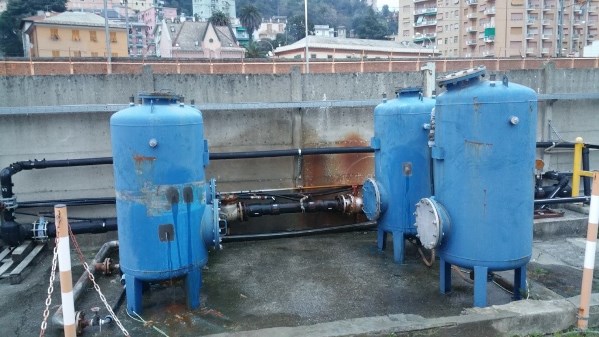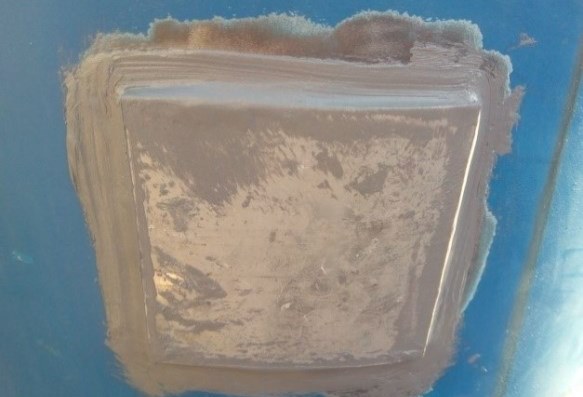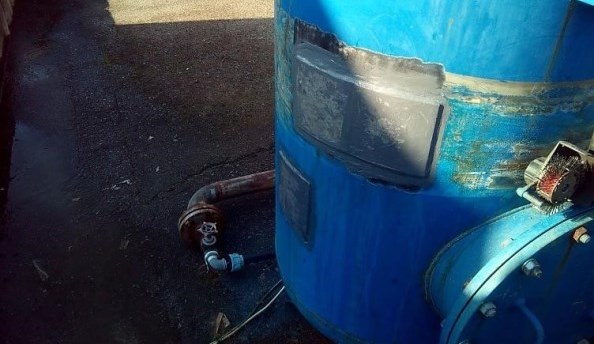When a vertical seawater tank sprang a leak at a coastal hydrocarbon storage tank farm in Genoa, Italy, time was of the essence.
Severe corrosion had led to a through-wall defect, from which seawater was leaking (Figure 1). The damaged area could not be dried, and shutting down the plant for any longer than two hours was not an option.

Making matters worse, three other tanks at the facility had suffered similar corrosion damage, albeit to a lesser extent. In those cases, the tank walls had thinned in certain spots, and further leaks were deemed possible in eight places, according to the operator.
The tight time window for repair meant that solutions with anything but the shortest of cure times were not an option for the client.
No Easy Solution
The ideal solution for repair work on a metallic surface with polymeric paste-grade composites is a surface that is dry, clean, and specially prepared, since these surfaces offer the best conditions for optimum adhesion and bonding of the repair material. Having ample time to carry out the repair is also helpful.
Some machinery and equipment, however, is simply too vital or expensive to remove from its location or take out of service, which means that achieving ideal surface conditions can be a challenge. This was the case for the tank at the Italian plant, where wetness had seeped through due to the leak.
On top of that, the equipment in need of treatment is vital to the operation of the plant in this case, and the facility didn’t have the capacity for extended periods of downtime. As a result, the repairs needed to be completed within a very short timeframe.
New Polymeric Repair Material for Wet Substrates
Given the limited options, the client chose a recently developed polymeric repair material from polymer systems provider Belzona (Harrogate, United Kingdom) that is designed specifically to deal with wet substrates and short working windows. The 1212 material—a surface tolerant epoxy composite—was used to cold-bond the metal repair plates to the tanks, in order to reinforce the weakened spots and seal the through-wall defect (Figure 2).

“The combination of fast curing and water-tolerant properties required for this repair was the main parameter when selecting the solution material,” says Belzona’s Peter Duke. “In order to minimize downtime, it is important that the repair material cures and develops its mechanical strength quickly. The material will cure rapidly after mixing the two components, even in low temperatures, without compromising on durability or strength.”
Conducting the Repair
The surface areas were rapidly prepared with a mechanical hand-held tool to remove the existing paint and achieve a more suitable working surface.
From there, the repair material was applied directly onto the leaking and damaged areas.
Metal plates were then cold-bonded using the same material, thus sealing the leak and reinforcing the weakened areas of the tank walls. The application was carried out directly onto the tanks, thereby reducing downtime to a minimum.
Within two hours, the repair material had cured to a satisfactory level.
“The company chose this solution, as it allowed them to bypass the wet surface issue without any wasteful downtime,” Duke says.
Historically, cold-curing with composite materials has been a versatile and effective option to repair damage to metallic surfaces, since the process does not require hot work and minimizes health and safety concerns. However, some conditions—such as those at the Italian tank farm—can pose a challenge for traditional materials.

In this case, the repair strategy proved capable of successfully repairing the leaking seawater tanks (Figure 3), and the client was able to resume plant operations within a matter of hours.
“Replacing the tanks outright would have required them to shut down the plant, drain the tanks, wait for, and then install expensive replacements,” Duke says. “In contrast, application was completed within a matter of hours, requiring no downtime and at a cost of less than €1,200.”